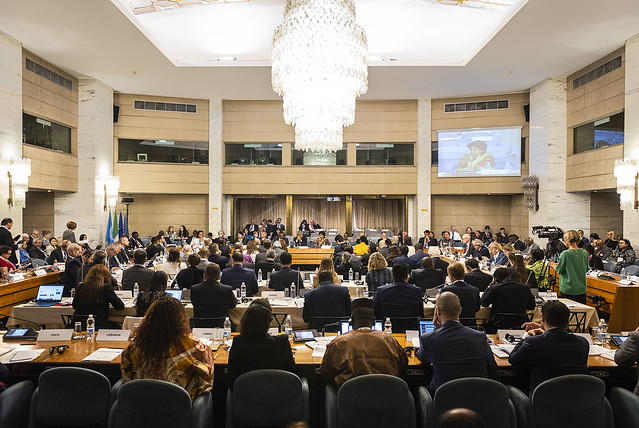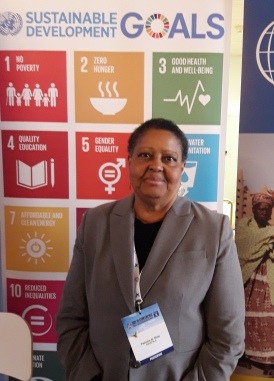NASPAA President Palmira Rios Represented NASPAA at a United Nations Department of Economic and Social Affairs Conference

On May 27, 2019, NASPAA President Palmira Rios represented NASPAA at a United Nations Department of Economic and Social Affairs conference entitled, "Peaceful, Just, and Inclusive Societies: SDG16 Implementation and the Path Towards Leaving No One Behind." It was a conference in preparation for The High-level Political Forum 2019, organized to be the United Nations central platform for follow-up and review of the 2030 Agenda for Sustainable Development and the Sustainable Development Goals (SDGs).
She formally answered two questions at a session called "Building Effective Institutions for Implementation of the SDGs at All Levels." Her replies are excerpted below:
FIRST QUESTION: NASPAA has over 300 schools of public policy and administration in some 25 countries. Some would say that these institutions have a direct connection, and responsibility, to the public sector workforce of the future. How can we more readily equip the public sector workforce for implementation of the SDGs?
We agree with the premise of your question. NASPAA has a responsibility in the formation of the public workforce and we believe that we must participate in the process of preparing the public sector workforce for the implementation of SDGs. NASPAA has over 320 Full Members, and 11 Associate Members in 25 nations (including the US territories and Hong Kong), in all continents and islands; 202 accredited programs in 183 schools, and 12 accredited programs in non-US schools. Our programs build capacities in core public administration functions in traditional fields like Human Resources Management, Fiscal Management and Intergovernmental relations and Decentralization (local government), and foster innovation by supporting emerging fields of specialization such as Risk Management and Resilience, NGO Management, Data and ICT. We believe that we must prepare future and current public leaders and employees to think critically and engage in future thinking, including uncertainty, as well that they must acquire skills such as emotional intelligence.
On March 2019 the Executive Council adopted SDG 16 as a guide for institutional mission and policies, and we are analyzing how we can incorporate the goals into our programs and activities, Code of Good Practices and definition of Public Service Values. Our evaluation of the interpretation and implementation of NASPAA's standards and competencies revealed their global applicability. Our competencies encourage programs to integrate the different components of the goal of diversity (faculty-students-curriculum), a core component of SDGs.
There is a generalized understanding that while the SDGs are interrelated, their successful implementation requires effective public institutions. The UN Committee of Experts on Public Administration concluded on their April 2019 session that sustainable development needs to enhance the capacity of the public sector in core functional areas of administration and as well as in "critical, complexity, futures and design thinking in addition to deliberative sills and emotional intelligence and appropriate use of frontier technologies." Furthermore, the Committee recalled that
"strengthening fiscal management at the national and subnational levels is integral to implementation of the SDGs and highlighted that sound fiscal management entails full ownership of domestic flows, reduction of illicit financial flows and corruption, strengthen fiscal transparency through open and collaborative budgeting processes , participatory and performance-based budgeting, and fiscal decentralization commensurate with subnational institutional capacity and arrangements in a given country."
NASPAA can play a significant role in the implementation of SDGs, particularly SDG16, through some of the following instruments:
- Teaching and Learning tools
- Case studies and Simulations, including our Global Student Simulation Competition
- Learning through Practices and Internships
- Curriculum revisions and syllabus
- Research and publications
- Electronic libraries
- Certificates and Continuing Education (to strengthen the competencies of current employees)
- New areas of specialization
- Support innovation in areas such as Big Data, Risk Management and Resilience, and Emotional Intelligence.
- Workshops and Colloquia (eg, since 2017 we have conducted workshops and Standards Colloquiums in the US, China, Qatar, Egypt, Mexico, Chile, and we are working on more in Colombia and Argentine)
- Collaborations with public administration national institutes
QUESTION 2: How can we articulate NASPAA's mission and standards with the global sustainable development goals?
As stated before, most of the goals adopted by the international community are recognized by NASPAA in our mission, standards and practices. A study of the accreditation reports submitted to NASPAA revealed that our programs already recognized the SDG goals as their Public Service Values (without using the terminology). Of the 10 top public service values identified by NASPAA programs in their Self Study Report, all are consistent with SDG 16:
- Ethical awareness/standards/norms (66%)
- Accountability (53%)
- Equity/Reduce disparities /social justice (53%)
- Transparency (50%)
- Diversity (45%)
Our academic standards are recognized by our peers as the basis for effective and efficient public administration and good governance. Although it may seem that our work is related to SDG 16, particularly SDG 16-6/7, our programs and projects are addressing practically all goals, primarily SDG 1 (end poverty), 4 (inclusive and equitable education), 5 (gender equality), 8 (inclusive and sustainable economic growth), 11 (sustainable cities) and 13 (combat climate change). The extent and strength of NASPAA's academic resources should be the basis for our incorporation into the SDG process and a global partner (SDG 17). The articulation between our mission and SDG implementation can be achieved if we add the following area of emphasis:
- From efficiency to effectiveness, competence and data driven sound policy making
- From diversity to inclusion and participation
- From representation to integrity, transparency and subsidiarity
In conclusion, we can affirm that NASPAA can and should become a global partner in the implementation of SDGs, particularly SDG 16. Our programs can provide the resources needed to the implementation of SDGs. NASPAA's commitment to advancing public service values is consistent with participating in the implementation of SDGs. The SDGs provides us with an important tool for addressing challenges to quality public affairs education such as: global, diversity and inclusion, engagement, and evaluation of standards and competencies. Engaging in this process will create an exceptional context to advance the understanding of public service values, in times when they are under siege. Therefore, NASPAA and its affiliated academic programs should engage in the implementation of SDGs to ensure the fulfillment of the global commitment to build sustainable and inclusive development that leaves no one behind.

